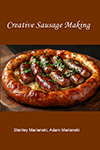Meats and Sausages
Chorizo de Soria
Soria is a city in north-central Spain, the capital of the province of Soria in the region of Castile and León. The sausage is made of lean pork and fat, although adding some beef is permitted. Salt, pimentón and garlic are added, the sausage is stuffed into large diameter pork or beef casings and dried.
| Meats | Metric | US |
|---|---|---|
| Lean pork | 700 g | 1.54 lb |
| Back fat, pork belly | 300 g | 0.66 lb |
Ingredients per 1000g (1 kg) of meat
| Salt | 28 g | 4.5 tsp |
| Cure #2 | 2.5 g | 1/2 tsp |
| Dextrose | 2.0 g | 1/2 tsp |
| Sugar | 3.0 g | 1/2 tsp |
| Pimentón | 25 g | 4 Tbsp |
| Garlic, smashed | 3.5 g | 1 clove |
Instructions
- Dice a half of the partially frozen fat (150 g) into 6-8 mm (1/4-3/8") cubes.
- Grind pork meat and remaining fat (150 g) through 10 mm (3/8”) plate.
- Mix meat, all fat with ll ingredients. Hold in refrigerator for 24 hours.
- Stuff into 26-80 mm pork or beef casings. Thin sausages were linked with butcher twine (rastra style) or formed into rings with ends tied together (herradura style), and the thick ones left in straight sections (vela style).
- Dry/ferment sausages at 22-24º C (72-75º F) for 48 hours.
- Dry at 15-12° C (59-53° F), 70-80% humidity, for 30-50 days depending on diameter. The sausages are considered dry when they lose about 33% of their original weight.
Notes
In traditional home production climatic conditions established parameters of drying (temperature and humidity). The sausages were dried at 10-28° C (50-82° F), 40-90% humidity, for 16-50 days, depending on time of the year and the diameter of the sausage. When the temperature dropped low a small wood burning fire was started to warm up the drying facility.
The sausage was stuffed into pork or beef casings of different diameters - 26-80 mm. Nowadays, large diameter synthetic protein-lined fibrous casings can be used.
Chorizo de Soria can be made with the following combination of meats: lean pork-60-70%, beef-0-15%, back fat, pork belly or both – 25-28%.
The sausage was stuffed into pork or beef casings of different diameters - 26-80 mm. Nowadays, large diameter synthetic protein-lined fibrous casings can be used.
Chorizo de Soria can be made with the following combination of meats: lean pork-60-70%, beef-0-15%, back fat, pork belly or both – 25-28%.


















